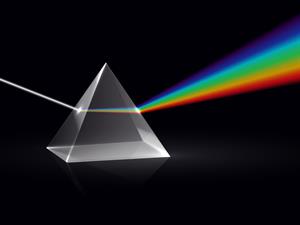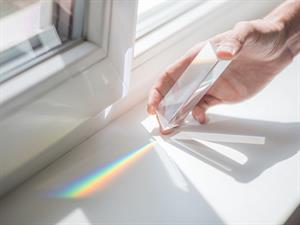PDF chapter test TRY NOW
Dispersion is a process of splitting white light into its seven constituent colours on passing through a transparent medium.
Combination of colours in light
This experiment requires a glass prism, a white sheet or wall and sunlight to prove that the light consists of different colours.

A narrow beam of sunlight is allowed to fall on one face of the glass prism. The light beam which enters the prism comes out of the other side of the prism, like a band of colours and falls on the white sheet or wall.
Inference
The spectrum of seven colours that resembles the colours in the rainbow can be seen. This proves that the sunlight is a mixture of seven colours, and these colours combine to produce white light.
The spectrum of seven colours that resembles the colours in the rainbow can be seen. This proves that the sunlight is a mixture of seven colours, and these colours combine to produce white light.

Newton's disc
Newton's disc is simply a top with seven colours. The disc can be made at home using circular cardboard, a pencil, colour paints or coloured papers, refill of a ball pen or a stick.
Newton's disc is simply a top with seven colours. The disc can be made at home using circular cardboard, a pencil, colour paints or coloured papers, refill of a ball pen or a stick.
- Make circular cardboard into a disc of \(10\ cm\).
- Make seven segments on the cardboard using a pencil.
- Now, paint these segments with all the rainbow colours or else you can even paste the coloured papers on the segments.
- Make a small hole at the centre of the disc and fix the tip of a ball pen refill loosely.
- Rotate the disc freely in the daylight.

Observation
When the disc is rotated freely at high speed, all seven colours get mixed and appears white. This type of disc is known as Newton's disc.
When the disc is rotated freely at high speed, all seven colours get mixed and appears white. This type of disc is known as Newton's disc.

Even a simple spinning top made of a pencil with seven colours will produce white colour when rotated freely in the daylight.

